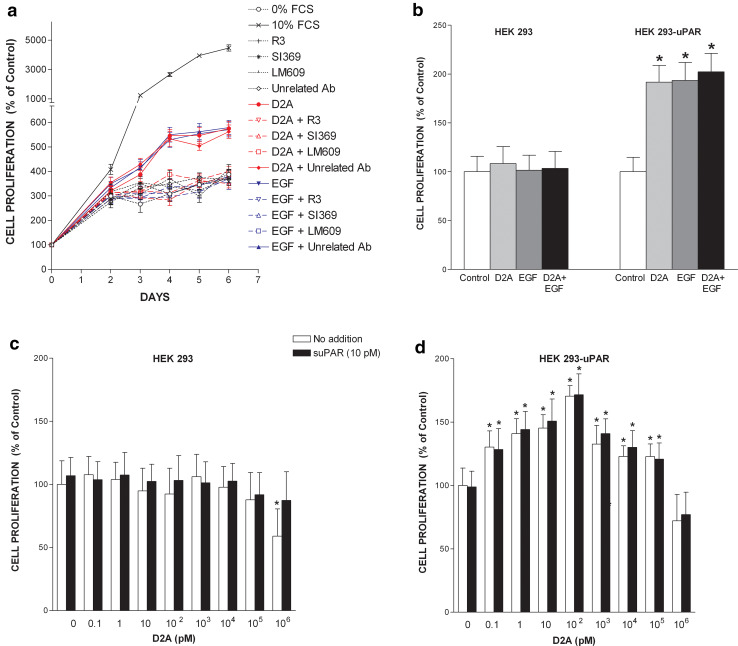Fig. 7.
uPAR, integrin αvβ3 and EGFR form a functional signalling complex. a uPAR and integrin αvβ3 are involved in the transduction of the mitogenic signal promoted by D2A and EGF. Time-course experiment showing the effects of peptide D2A (100 pM) or EGF (5 ng/ml = 0.80 nM) in the absence or in the presence of various antibodies (each at 1 μg/ml): LM609, a blocking monoclonal anti-αvβ3; R3, a monoclonal anti-uPAR; SI369, a polyclonal anti-uPAR and an unrelated control antibody on proliferation of HT-29 cells. Data from three experiments are the mean ± SD. Number of cells cultured in serum-free media without D2A or EGF and in the absence of any antibody is referred to as 100% proliferation (control). The conditions 10% FCS, D2A, D2A + unrelated Ab, EGF and EGF + unrelated Ab are significantly different (p < 0.01) from control (0% FCS) as determined by ANOVA test. b The proliferation-promoting effects of D2A and EGF requires uPAR expression, however, D2A and EGF mitogenic effects are not additive. Proliferation of either HEK-293 or HEK-293-uPAR cells was stimulated with D2A (100 pM), EGF (1 ng/ml or 0.16 nM) or both mixed together as indicated. Data are the mean ± SD (n = 3) of cell numbers determined at day 4. Control corresponds to the number of cells cultured in serum-free media without D2A and EGF (100% proliferation). *p < 0.05 compared to control. c, d Cell proliferation in response to D2A challenge requires the expression of uPAR. Comparison of the effects of increasing doses of D2A in the presence or in the absence of suPAR on HEK-293 cells (devoid of uPAR) (c), and HEK-293-uPAR cells (expressing uPAR) (d). Cell numbers were determined at day 4. Number of cells cultured in serum-free media and in the absence of D2A and suPAR is considered to be 100% cell proliferation (control). Data shown as mean ± SD (n = 3), *p < 0.01 compared to control

